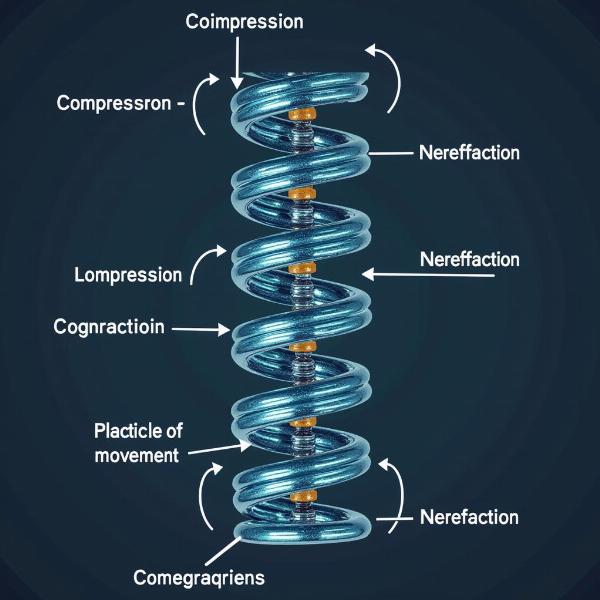Longitudinal wave, a fundamental concept in physics, often leaves Hindi speakers searching for a clear explanation. Understanding its meaning in Hindi is crucial for grasping various scientific phenomena. This article will delve into the “longitudinal wave meaning in Hindi,” exploring its definition, characteristics, examples, and relevance in different fields.
Understanding Longitudinal Waves: An In-Depth Look
What exactly is a longitudinal wave? In simple terms, a longitudinal wave is a wave in which the particles of the medium vibrate parallel to the direction of wave propagation. Imagine a slinky spring being pushed and pulled along its length. The compressions and rarefactions created along the slinky demonstrate the movement of particles in a longitudinal wave.
 Longitudinal Wave Slinky Example
Longitudinal Wave Slinky Example
Unlike transverse waves, where particles oscillate perpendicular to the wave direction (like waves on a string), longitudinal waves exhibit a back-and-forth motion along the wave’s path. This distinction is crucial for understanding the nature and behavior of different wave types.
Longitudinal Wave Meaning in Hindi: दीर्घायु तरंग (Dirghaayu Tarang)
The Hindi term for longitudinal wave is दीर्घायु तरंग (Dirghaayu Tarang). While ‘Dirghaayu’ literally translates to ‘long-lived,’ in this context, it refers to the wave’s propagation along its length. ‘Tarang’ simply means ‘wave.’ This term accurately captures the essence of a longitudinal wave, emphasizing the alignment of particle motion with the wave’s direction.
Breaking Down the Hindi Terminology
- दीर्घायु (Dirghaayu): Relates to the longitudinal nature of the wave, highlighting its movement along a specific direction.
- तरंग (Tarang): The general Hindi word for wave, encompassing various types of wave phenomena.
Examples of Longitudinal Waves in Everyday Life
Longitudinal waves are not just abstract concepts confined to physics textbooks. We encounter them in our daily lives. Sound waves, for instance, are a prime example. When you speak, your vocal cords vibrate, creating compressions and rarefactions in the surrounding air. These disturbances travel as longitudinal waves, carrying sound to the listener’s ears.
Other examples include seismic P-waves generated during earthquakes and ultrasound waves used in medical imaging. These diverse applications demonstrate the significance of understanding longitudinal waves in various fields.
Importance of Longitudinal Waves in Different Fields
The study of longitudinal waves is essential across several disciplines. In medicine, ultrasound technology utilizes longitudinal waves to create images of internal organs, aiding diagnosis and treatment. In geophysics, the analysis of seismic P-waves helps scientists understand the Earth’s internal structure and predict earthquakes. Even in music, the understanding of sound waves as longitudinal waves is crucial for instrument design and acoustics.
Conclusion
Understanding “longitudinal wave meaning in Hindi” as दीर्घायु तरंग (Dirghaayu Tarang) unlocks the door to comprehending a fundamental principle in physics. From sound waves to seismic waves, these longitudinal disturbances play a vital role in various natural phenomena and technological applications. By grasping their characteristics and examples, we can appreciate the significance of these waves in our world.
FAQ
- What is the basic difference between transverse and longitudinal waves? In transverse waves, particles vibrate perpendicular to the wave direction, while in longitudinal waves, they vibrate parallel to it.
- Can longitudinal waves travel through vacuum? No, longitudinal waves require a medium for propagation, unlike electromagnetic waves.
- What is the speed of sound in air? The speed of sound in air is approximately 343 meters per second at room temperature.
- How are longitudinal waves used in medical imaging? Ultrasound technology utilizes longitudinal waves to create images of internal organs, helping in diagnosis.
- What are some examples of longitudinal waves other than sound? Seismic P-waves and ultrasound waves are examples of longitudinal waves.
- What is the meaning of ‘Tarang’ in Hindi? ‘Tarang’ means ‘wave’ in Hindi.
- Why is understanding longitudinal waves important? Understanding longitudinal waves is essential for comprehending various natural phenomena and technological applications in fields like medicine, geophysics, and music.
Meaning-Hindi.in is your trusted partner for all your Hindi translation needs. We offer a comprehensive range of translation services, from business and legal documents to technical manuals and website localization. Our expert team ensures accurate and culturally sensitive translations, catering to diverse industries. Whether you need quick translation services or specialized industry expertise, Meaning-Hindi.in is here to assist you. Contact us today at [email protected] or +91 11-4502-7584. Let Meaning-Hindi.in bridge the language gap for you.